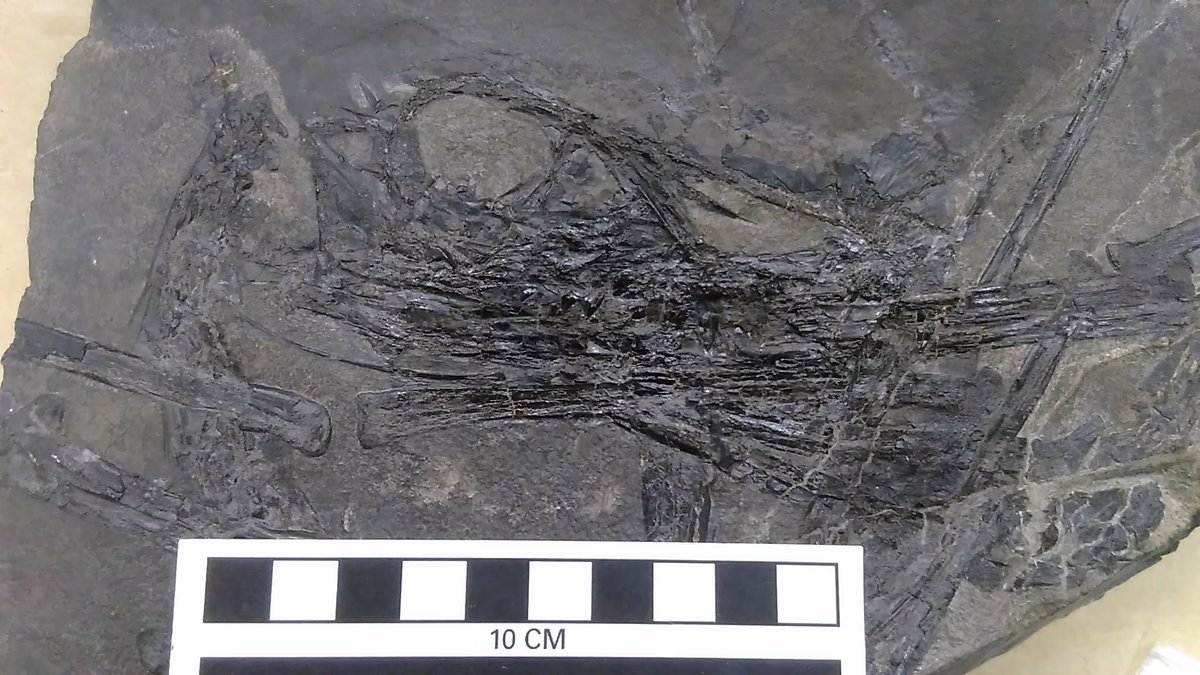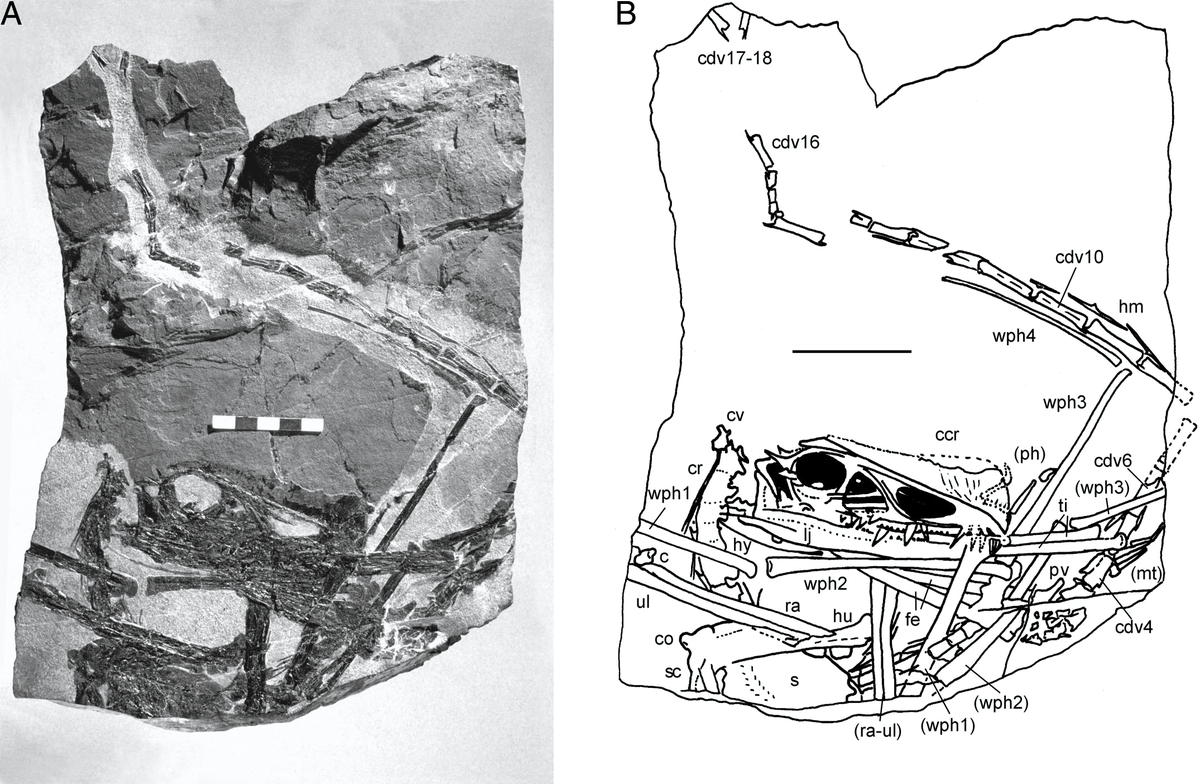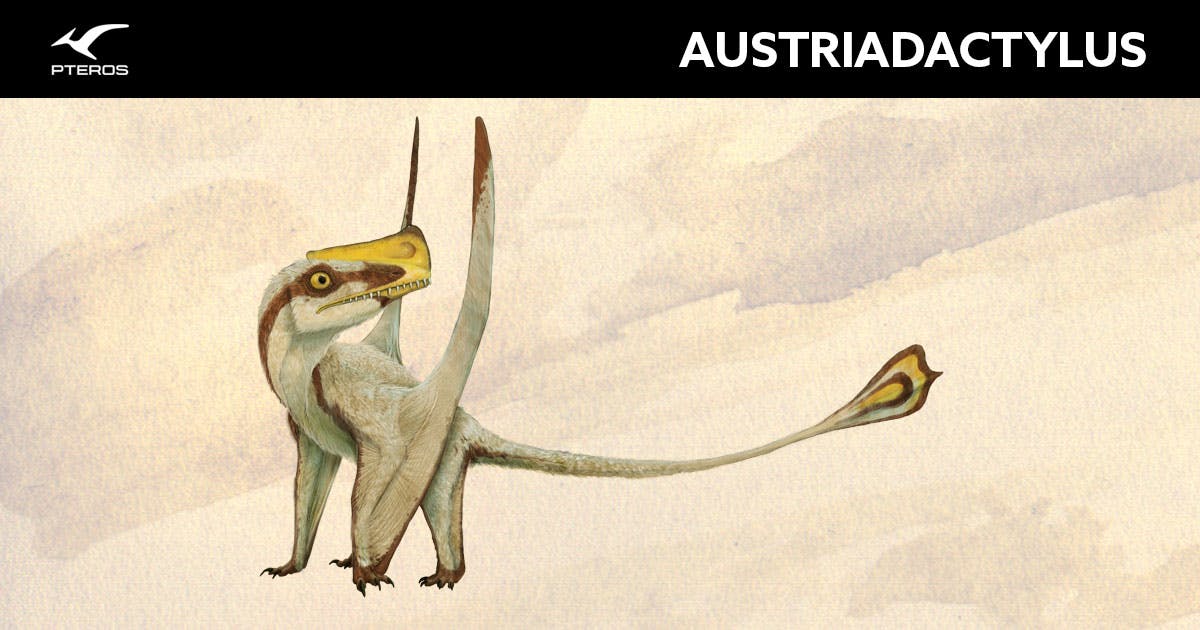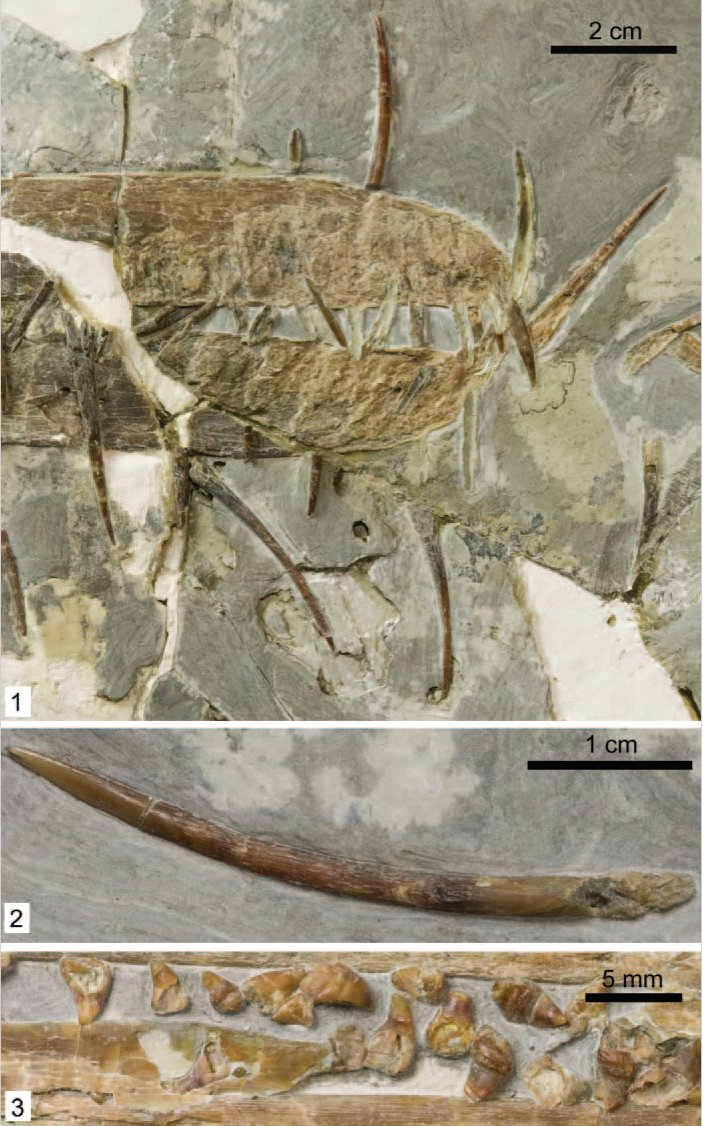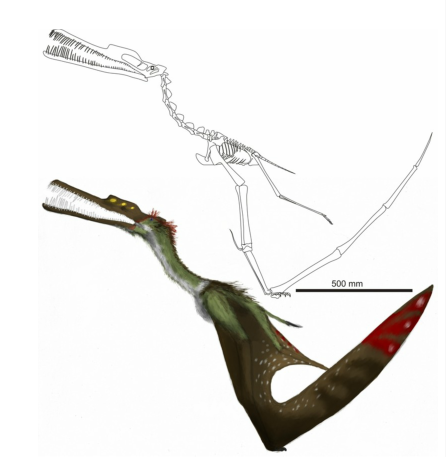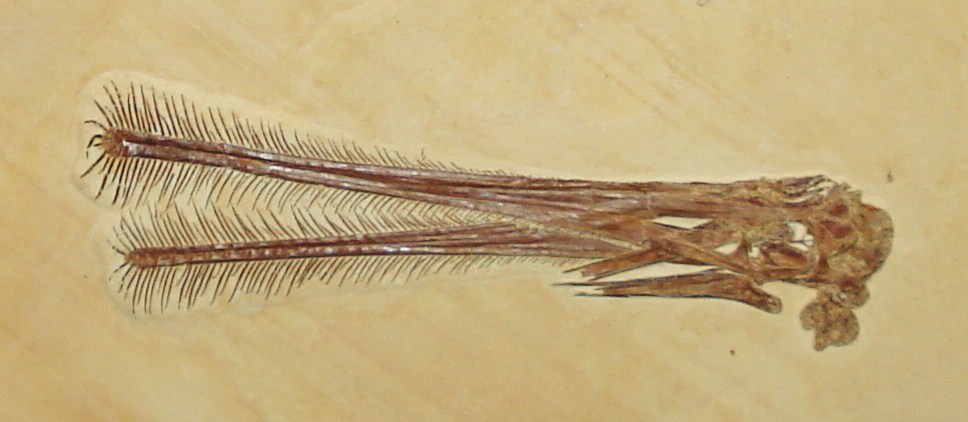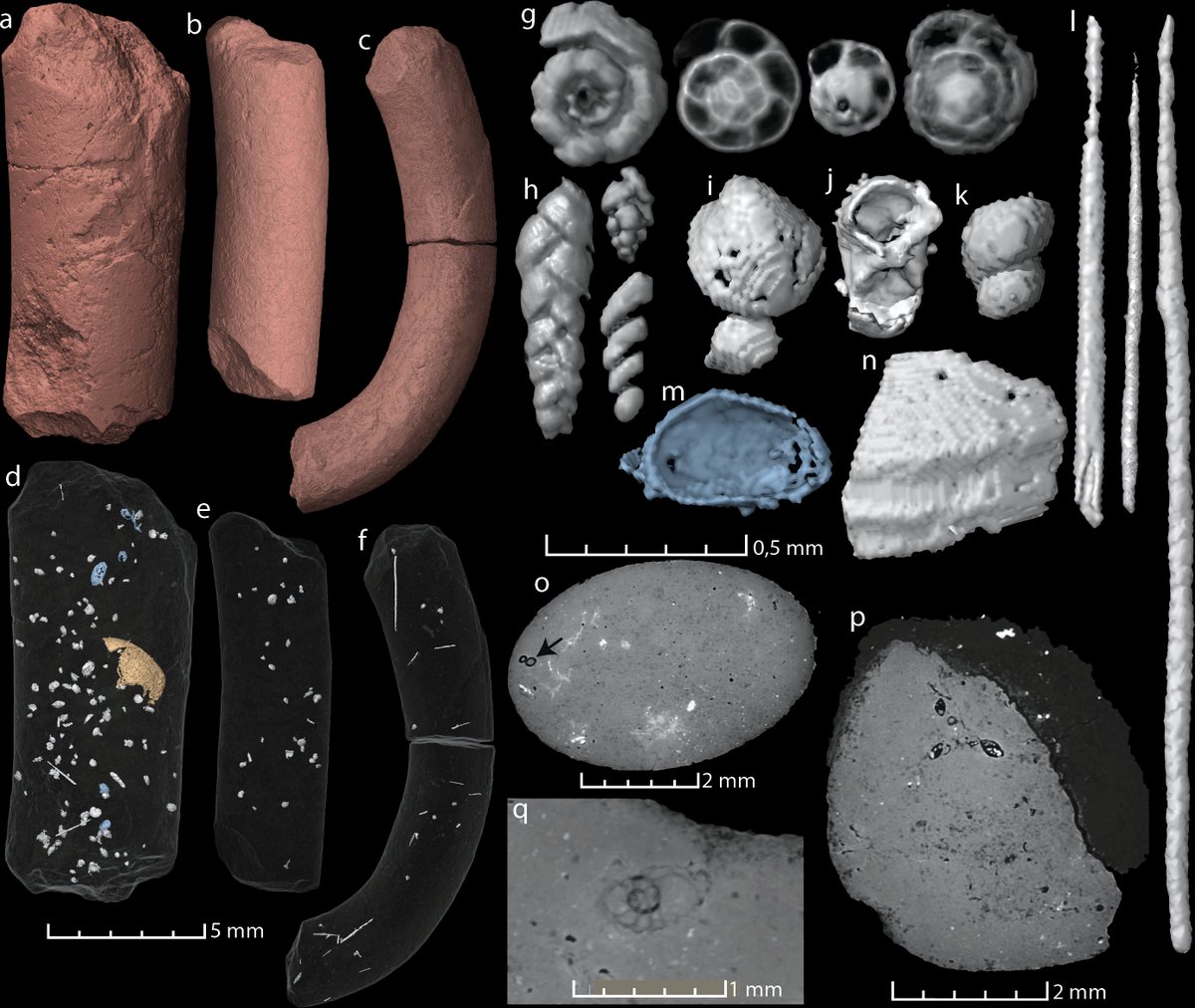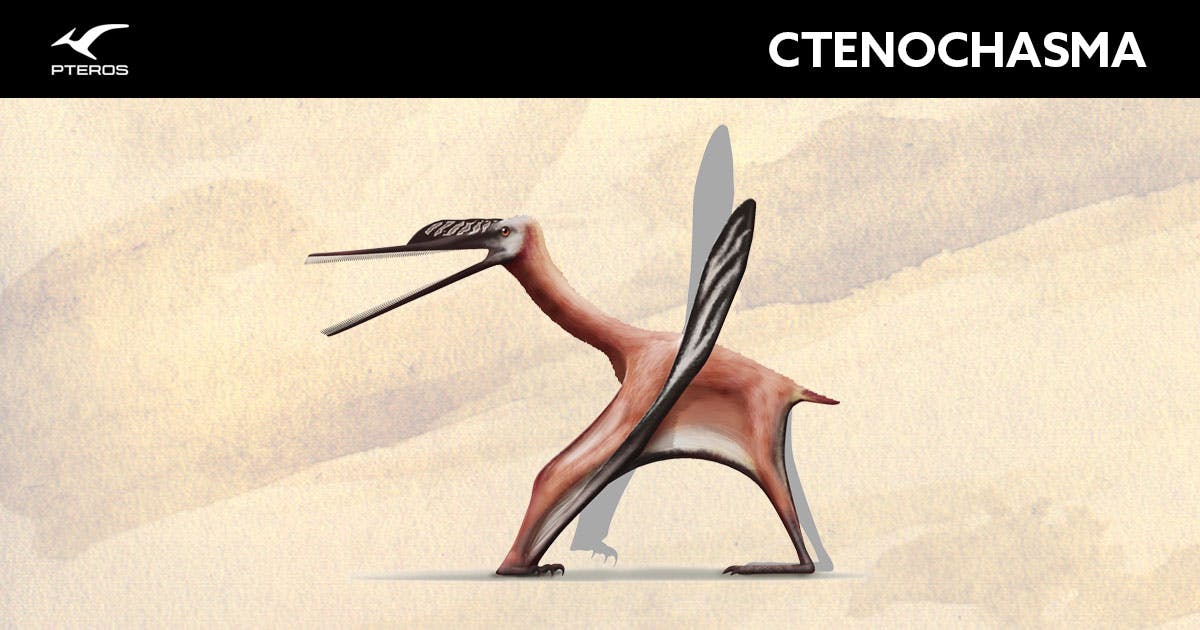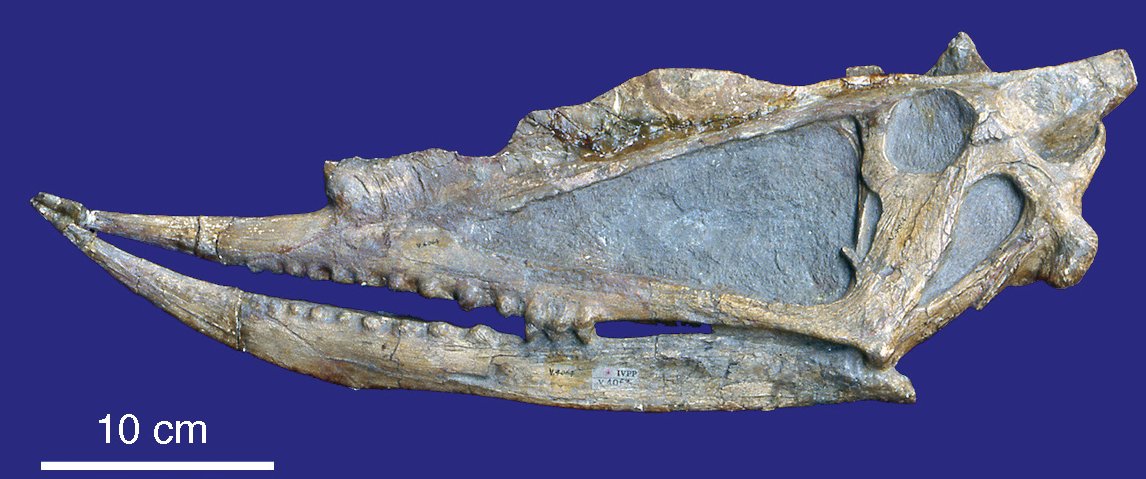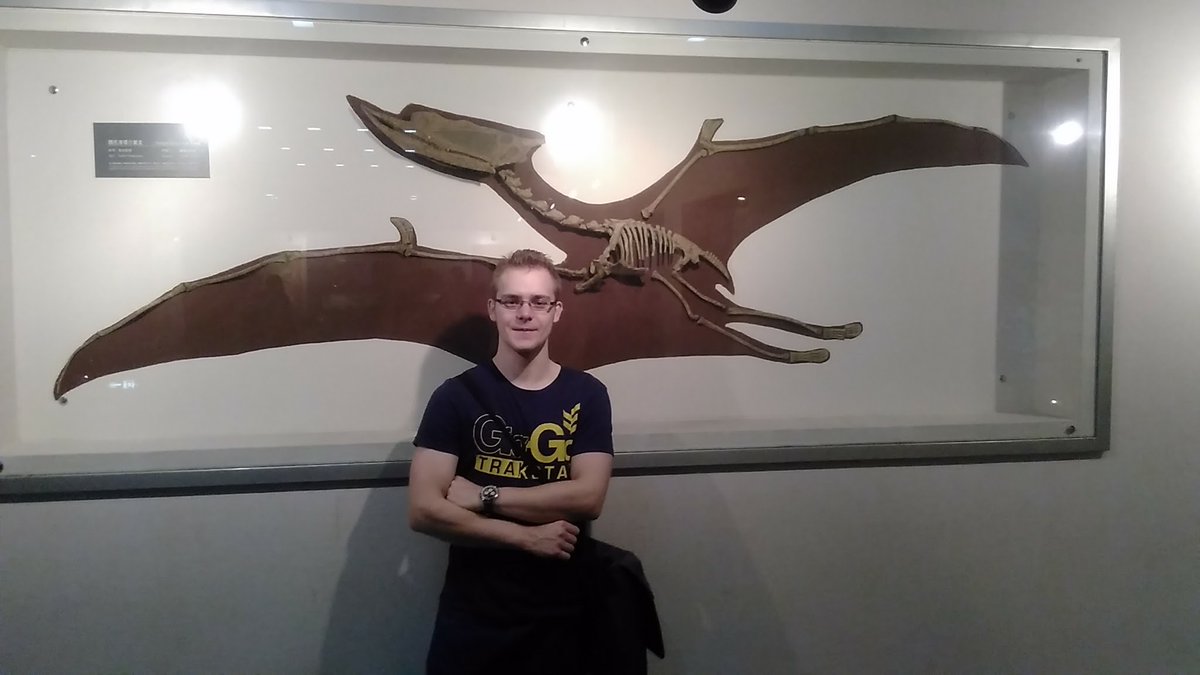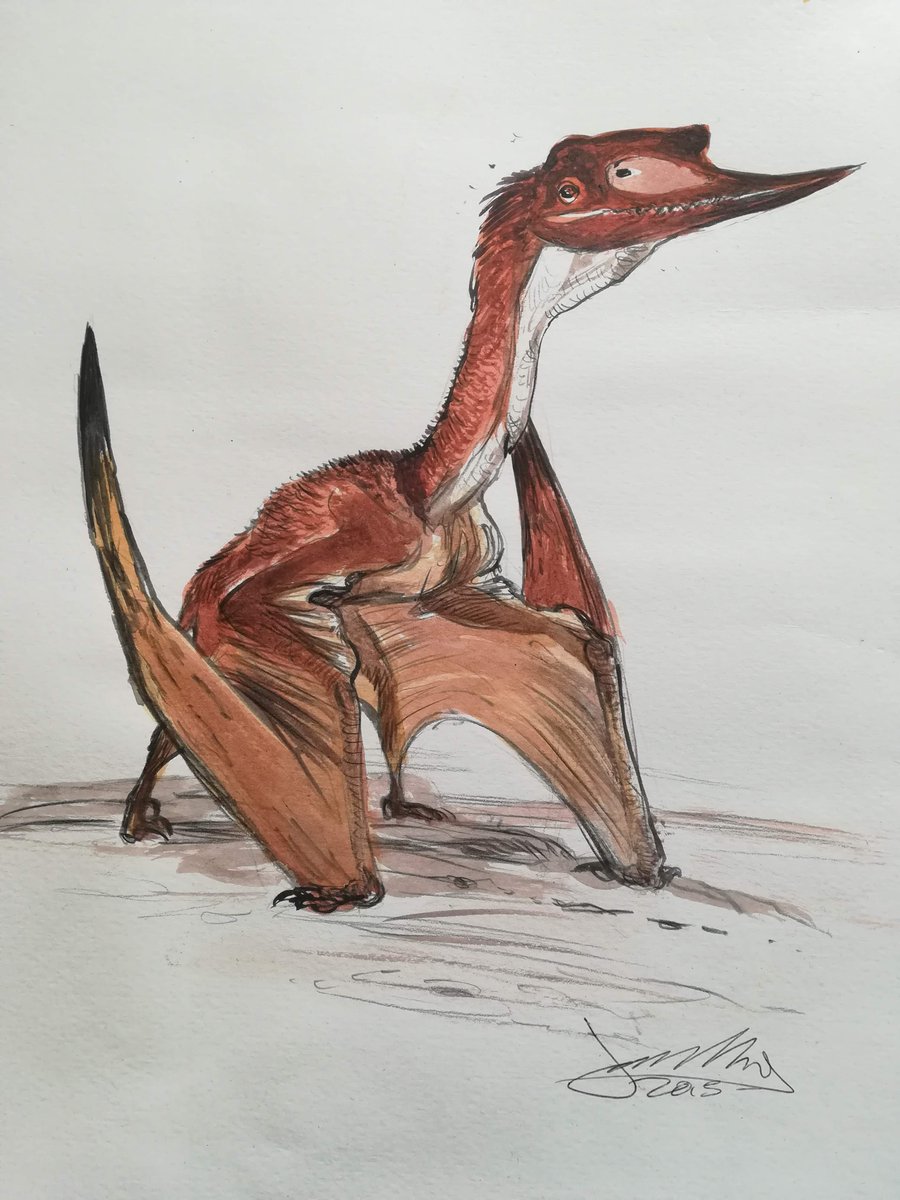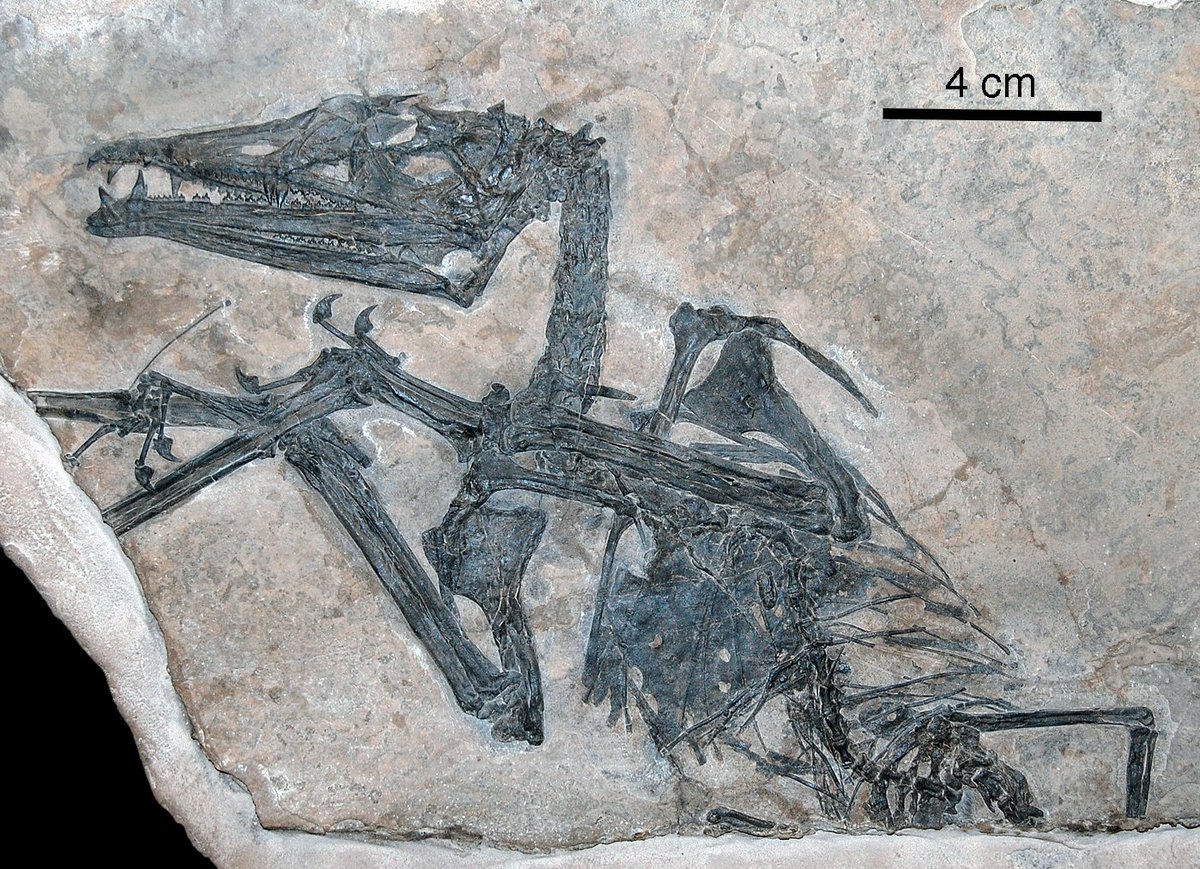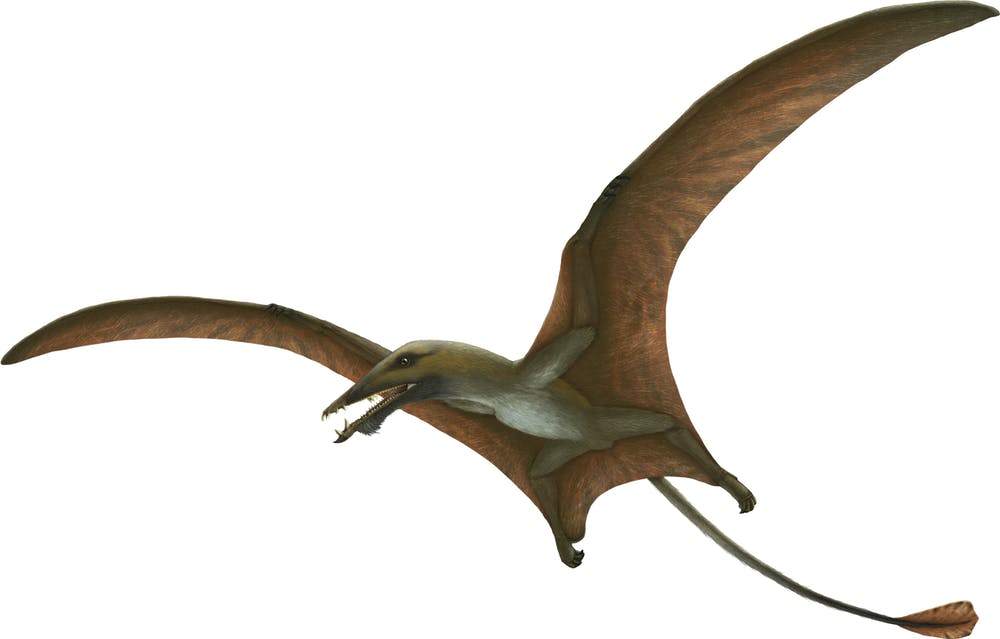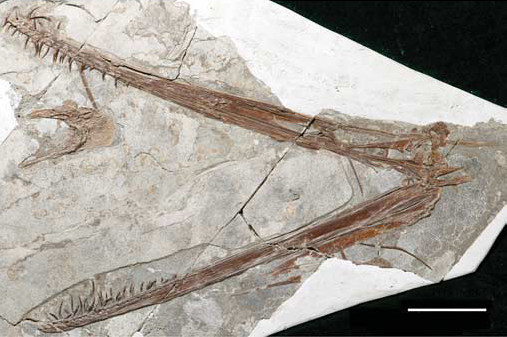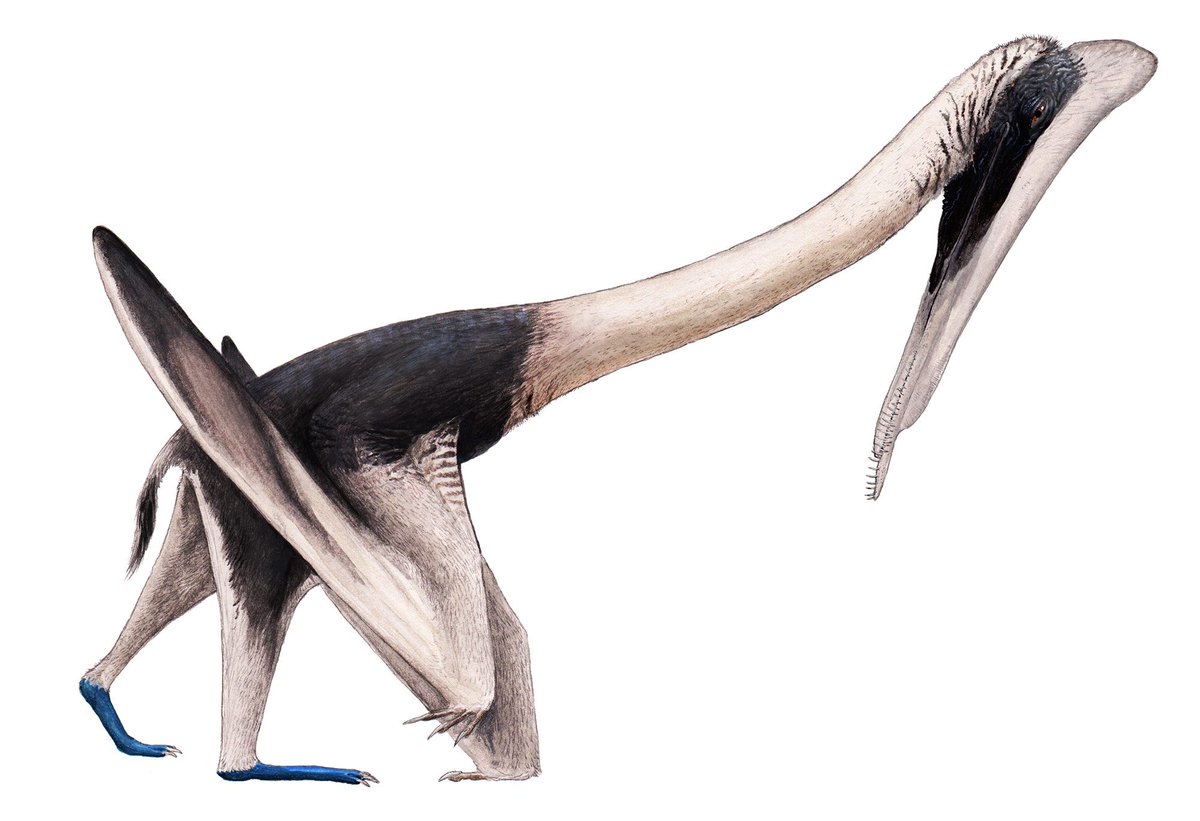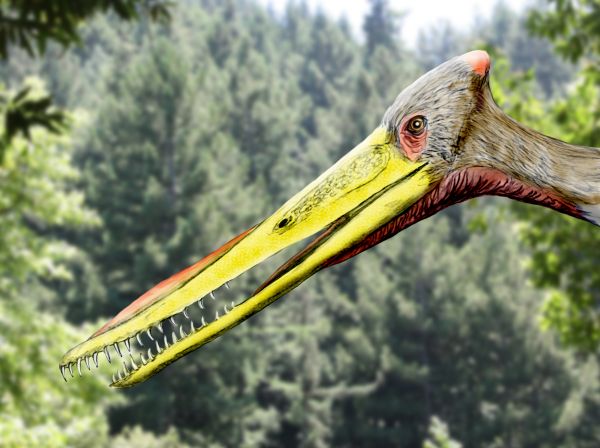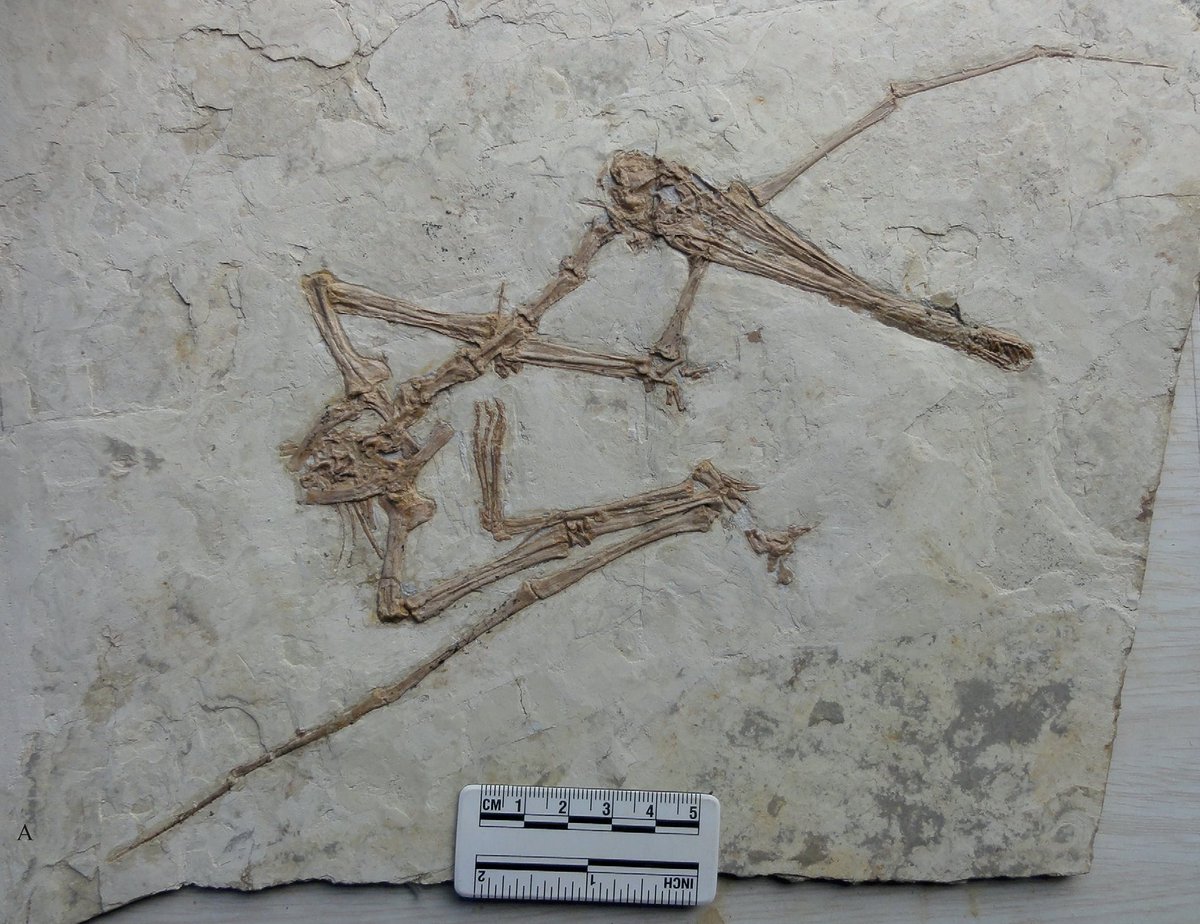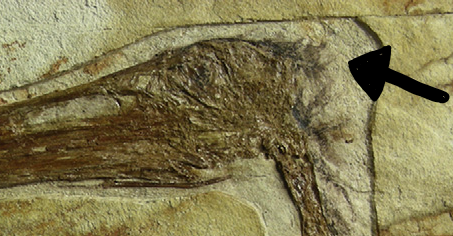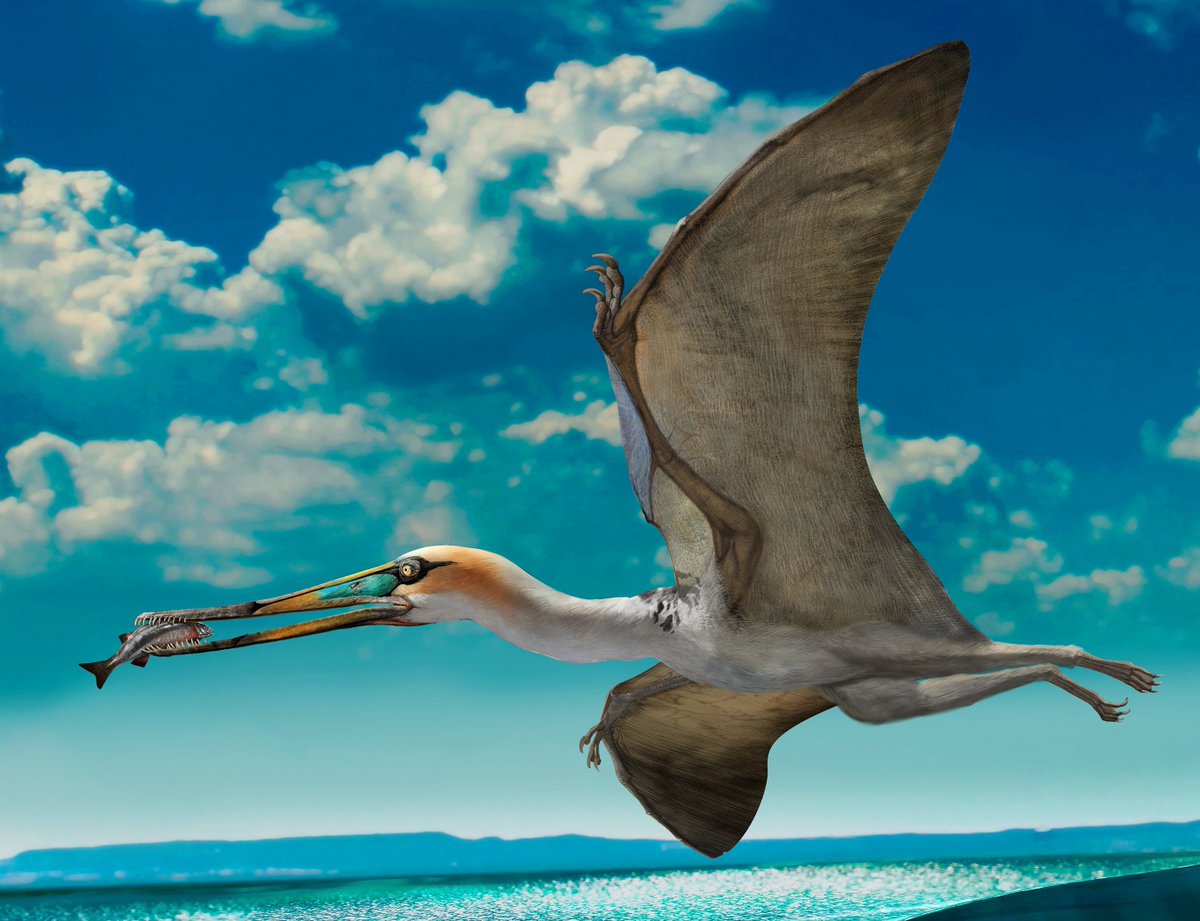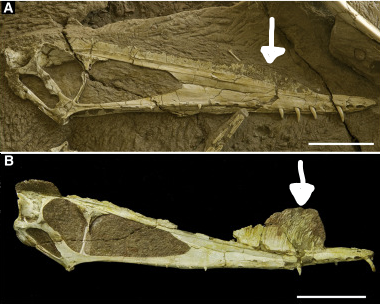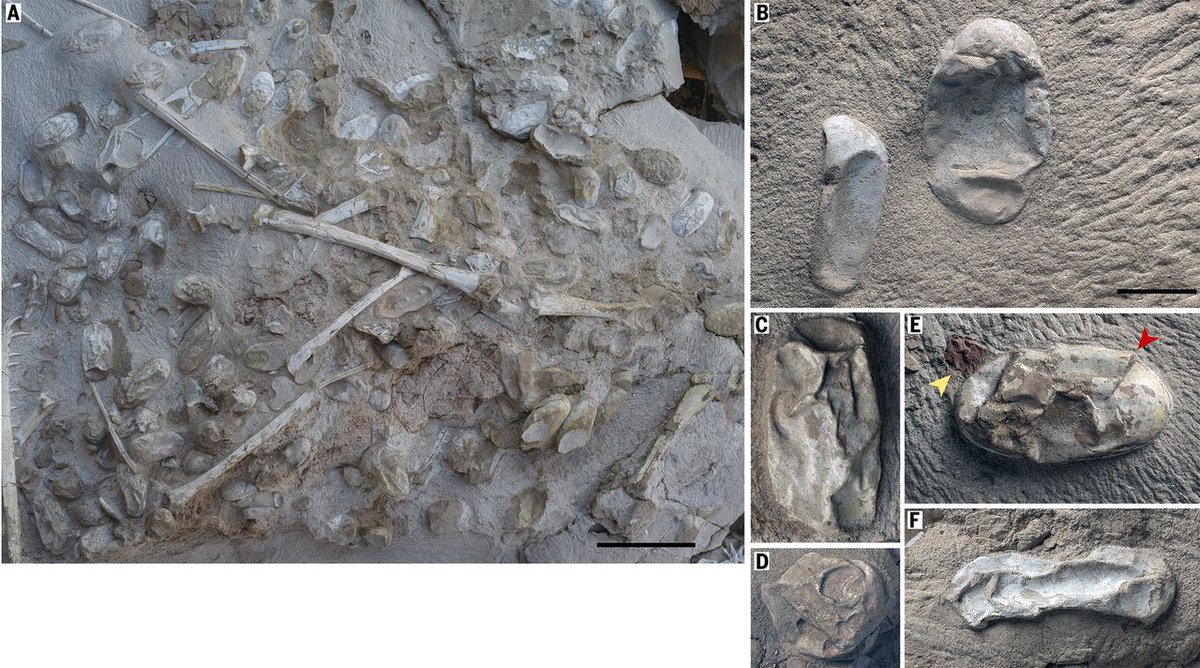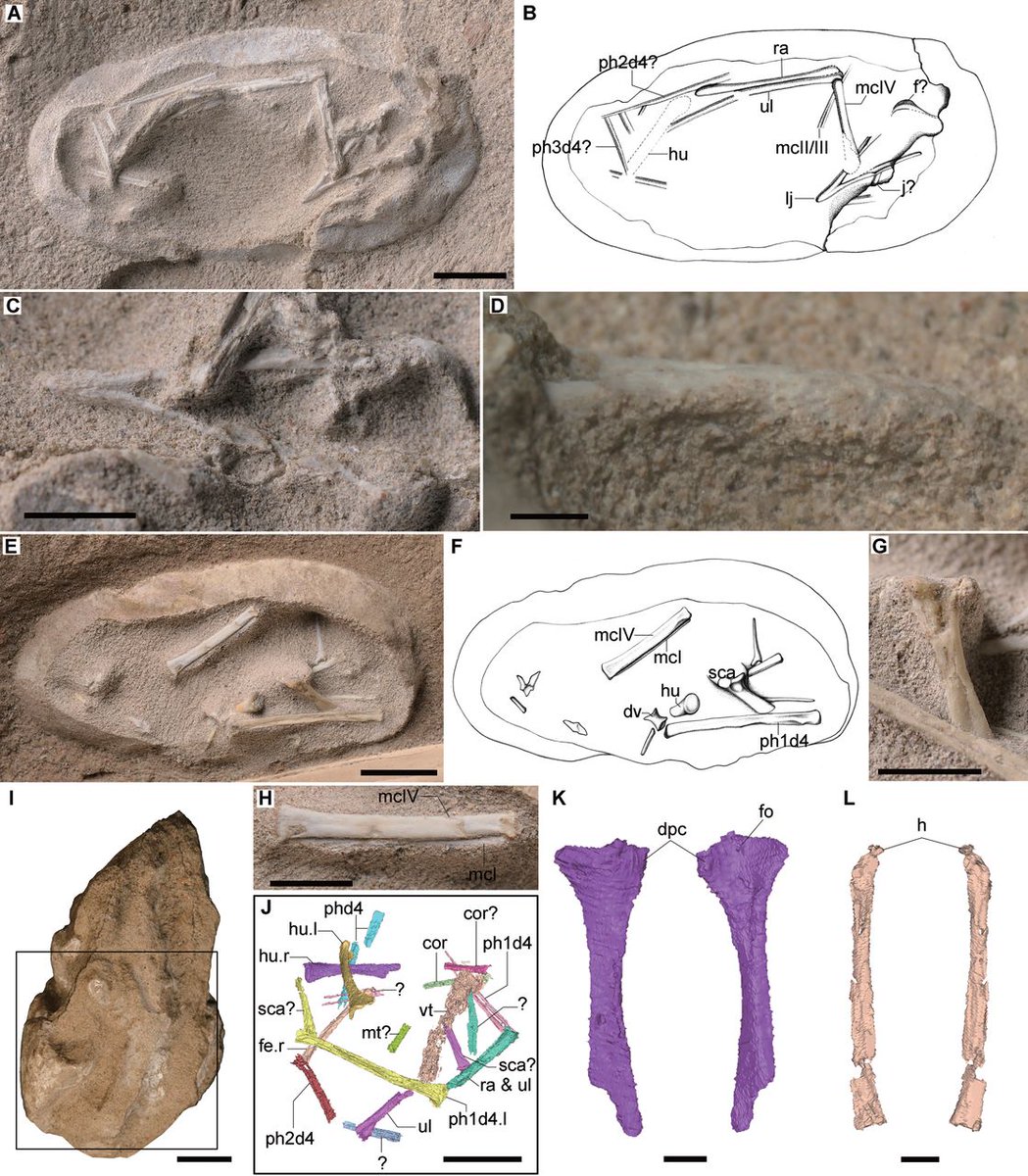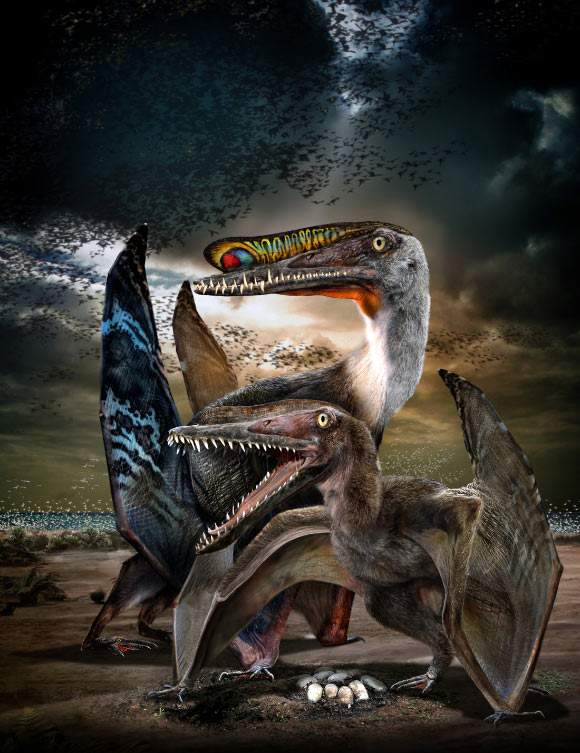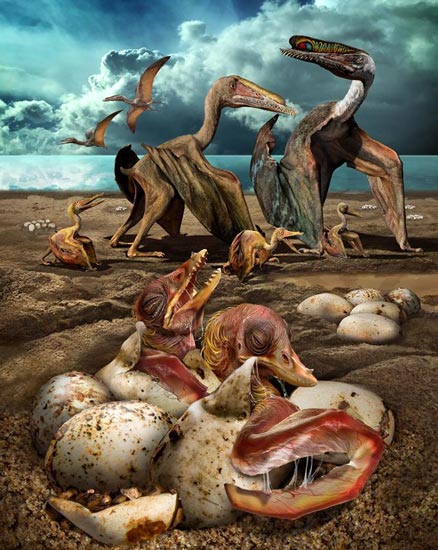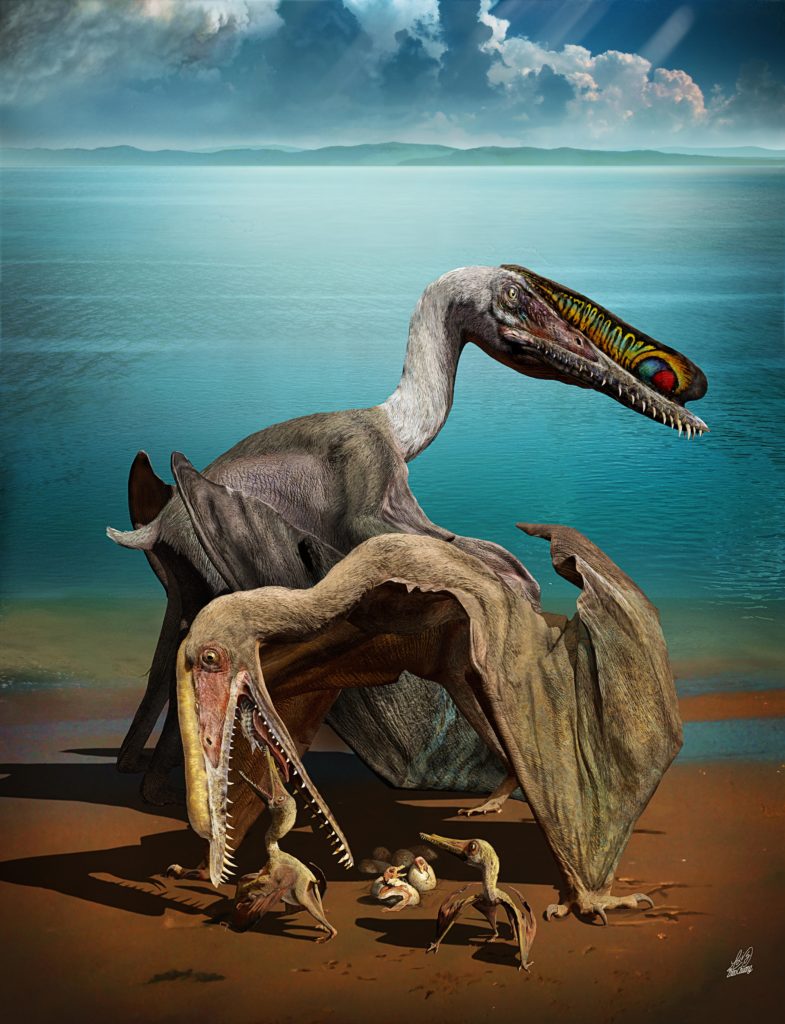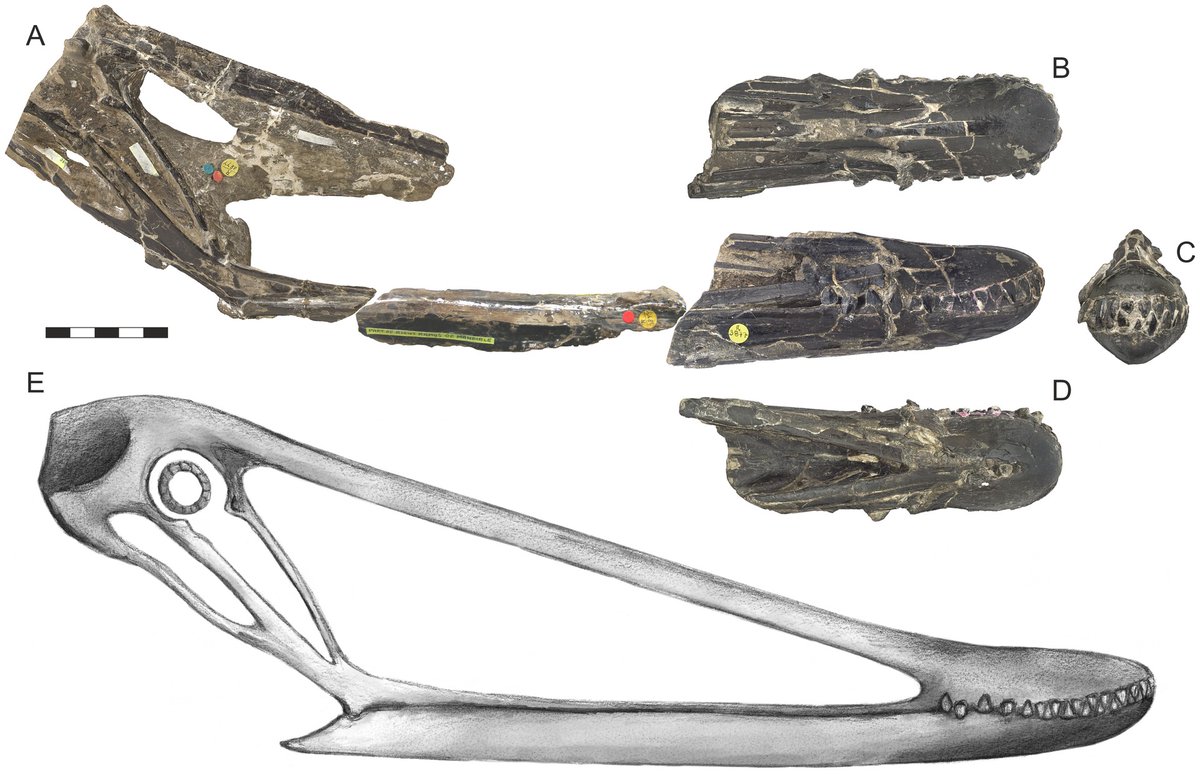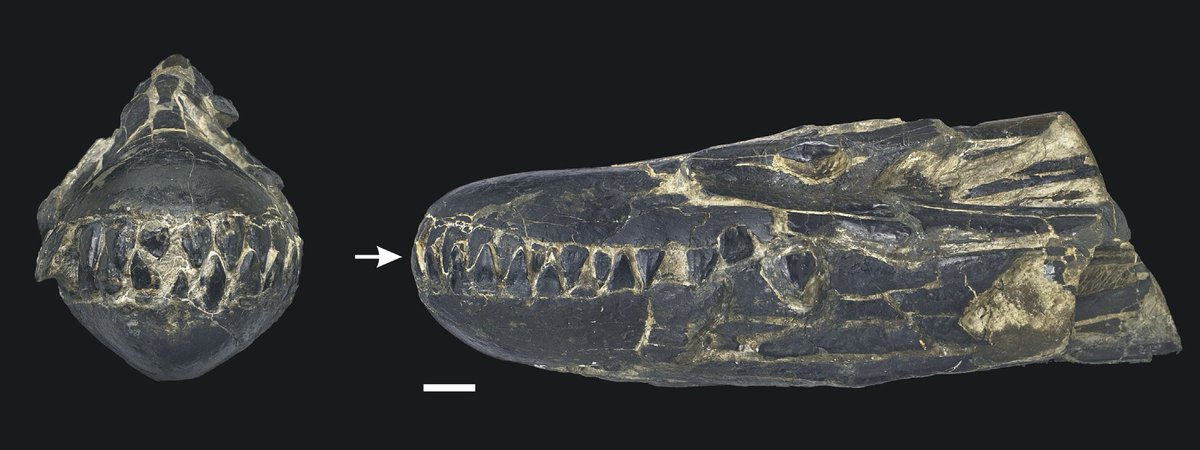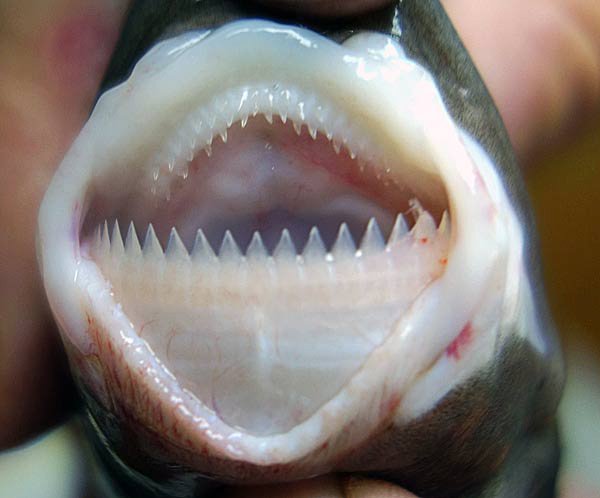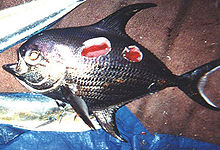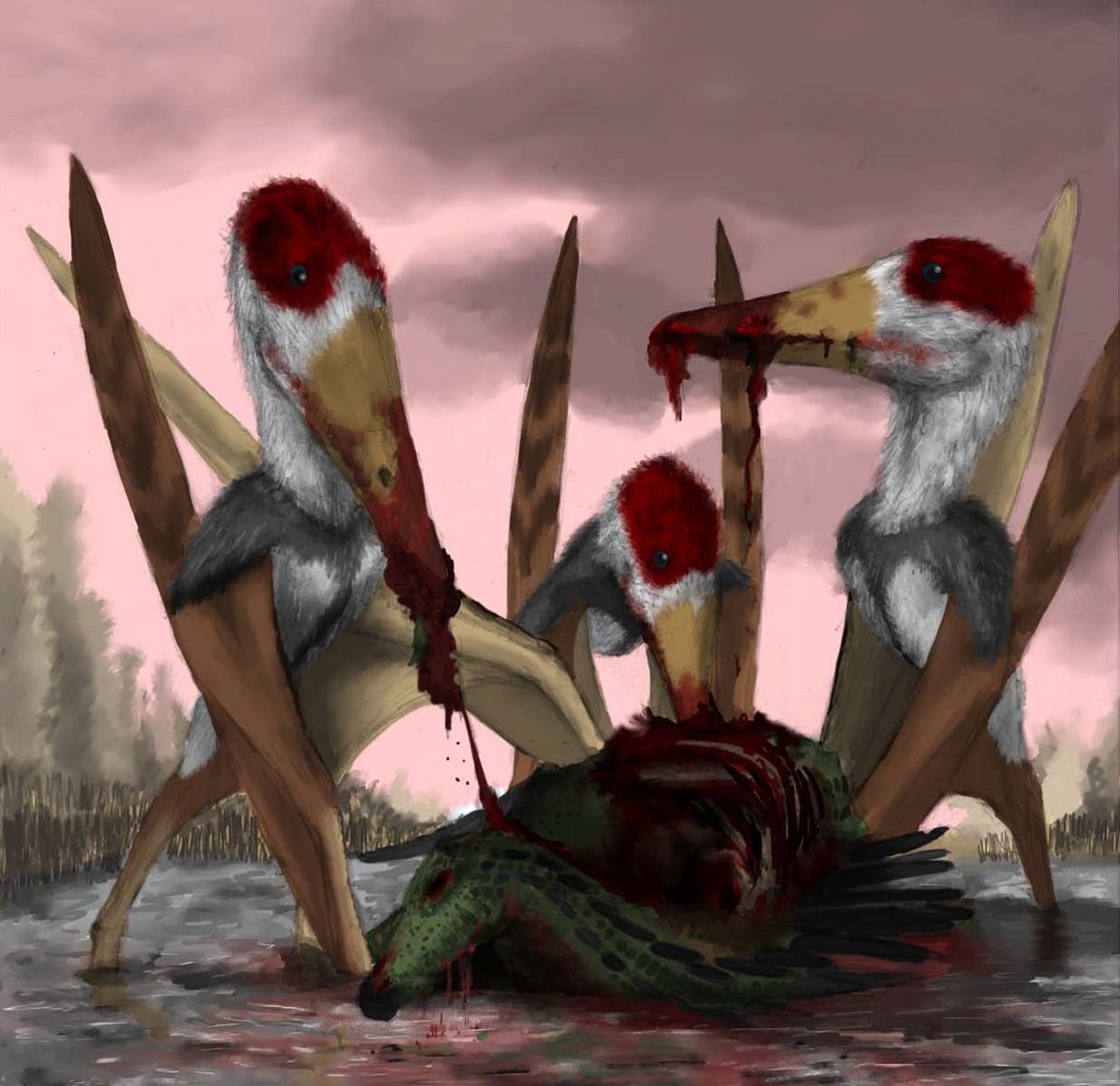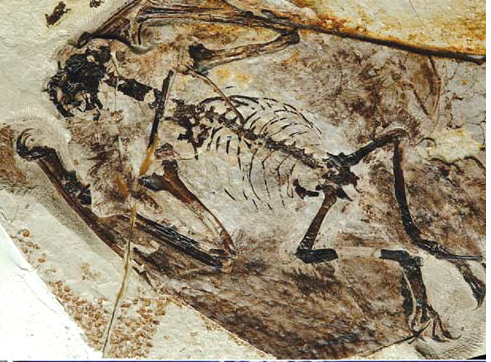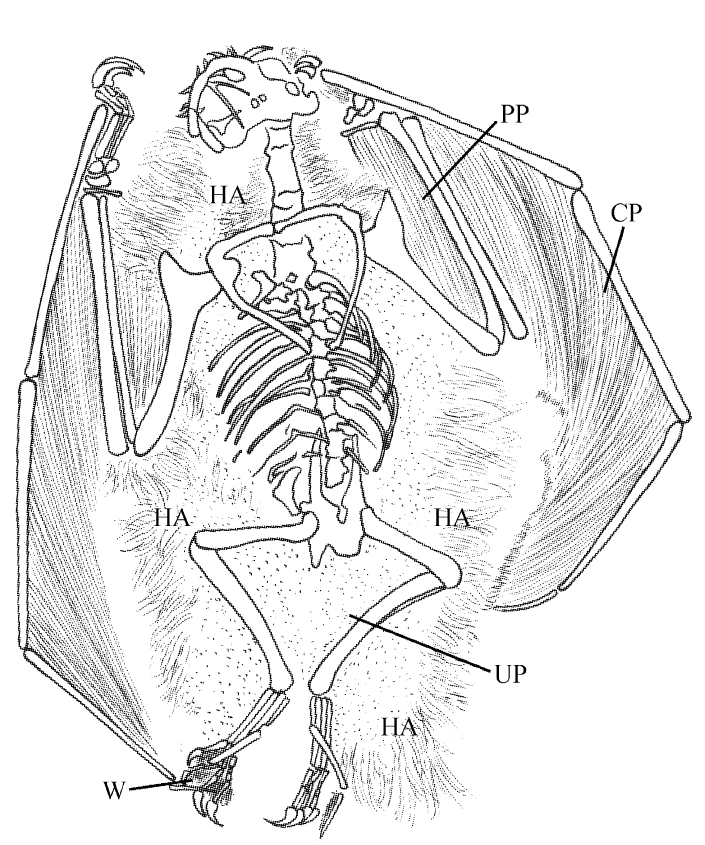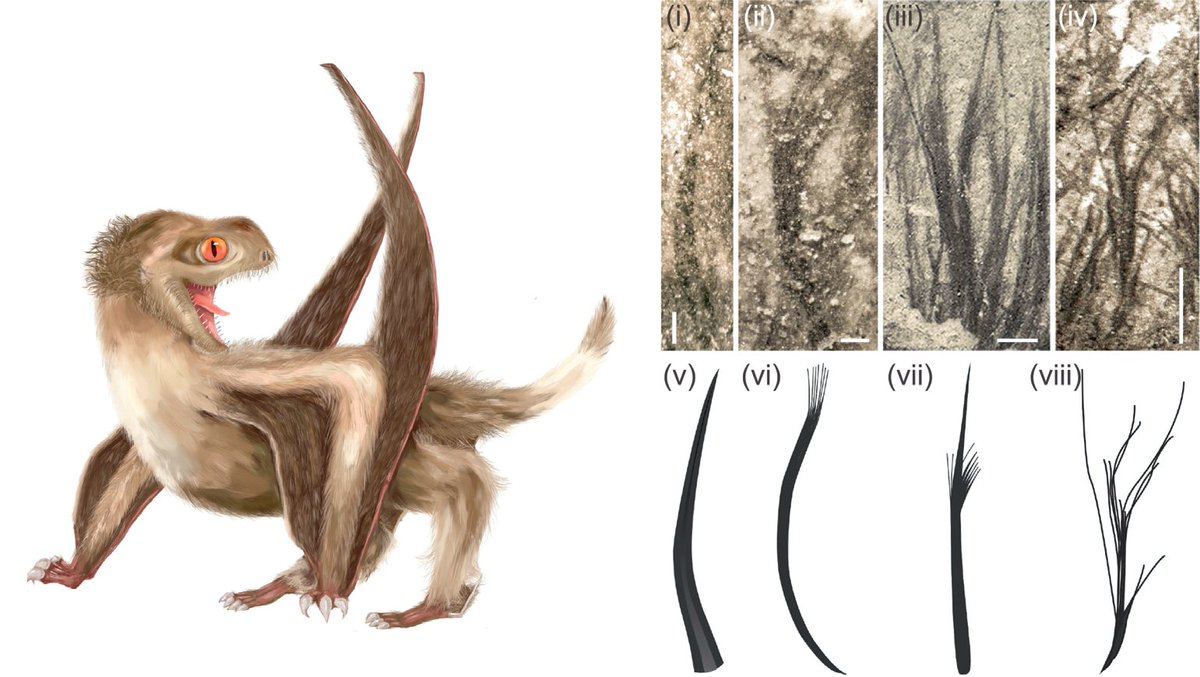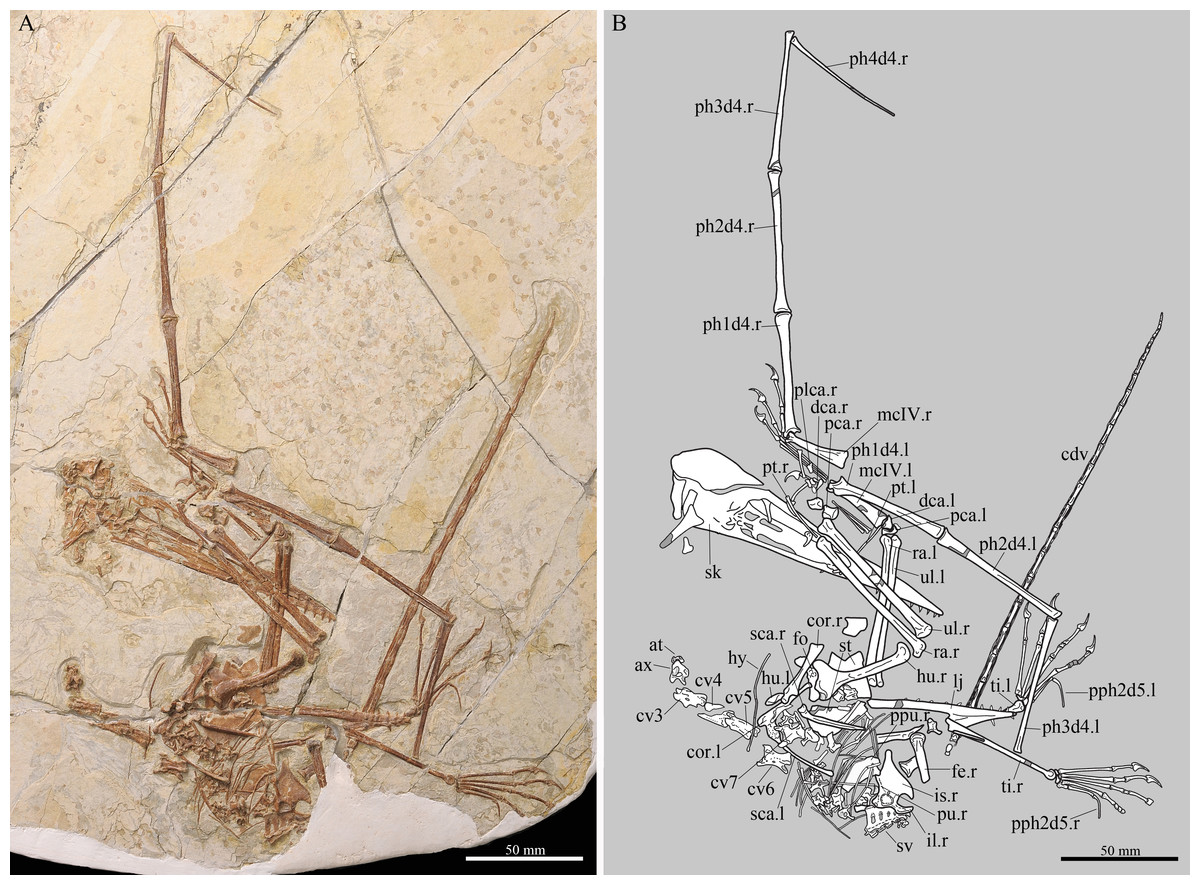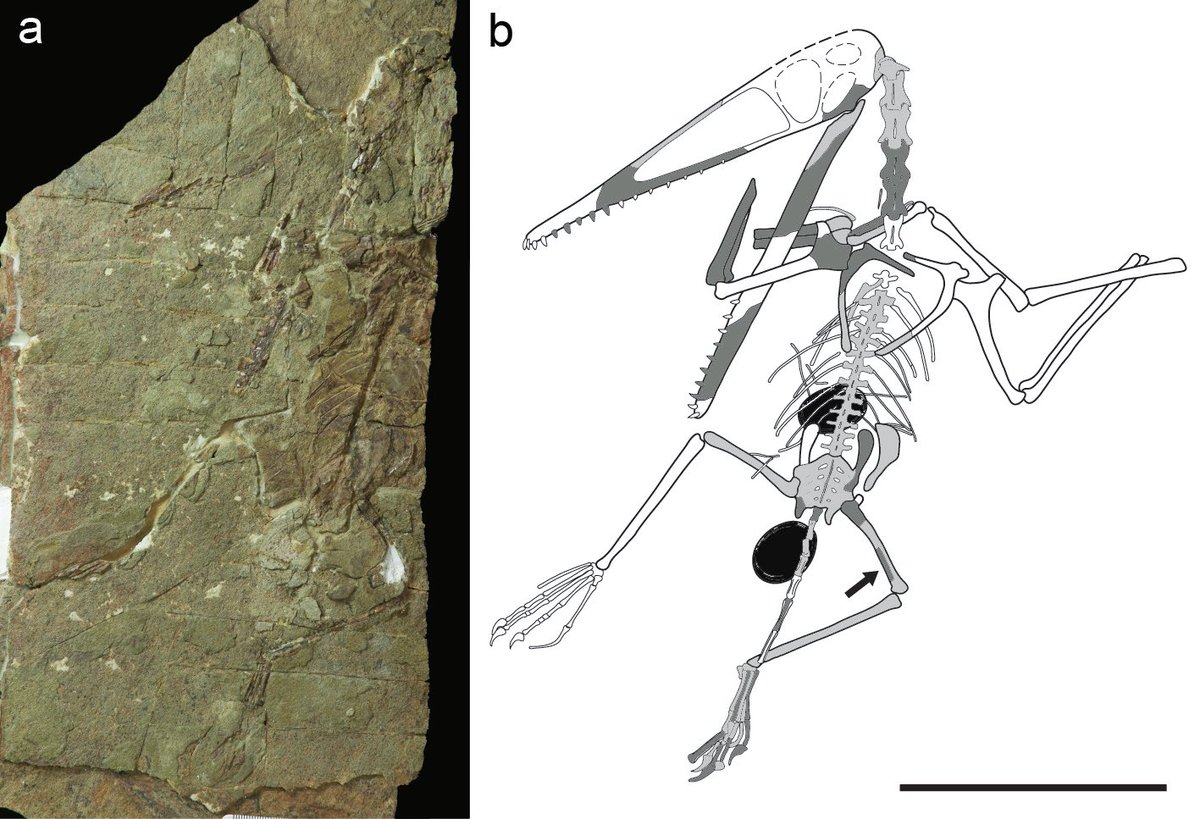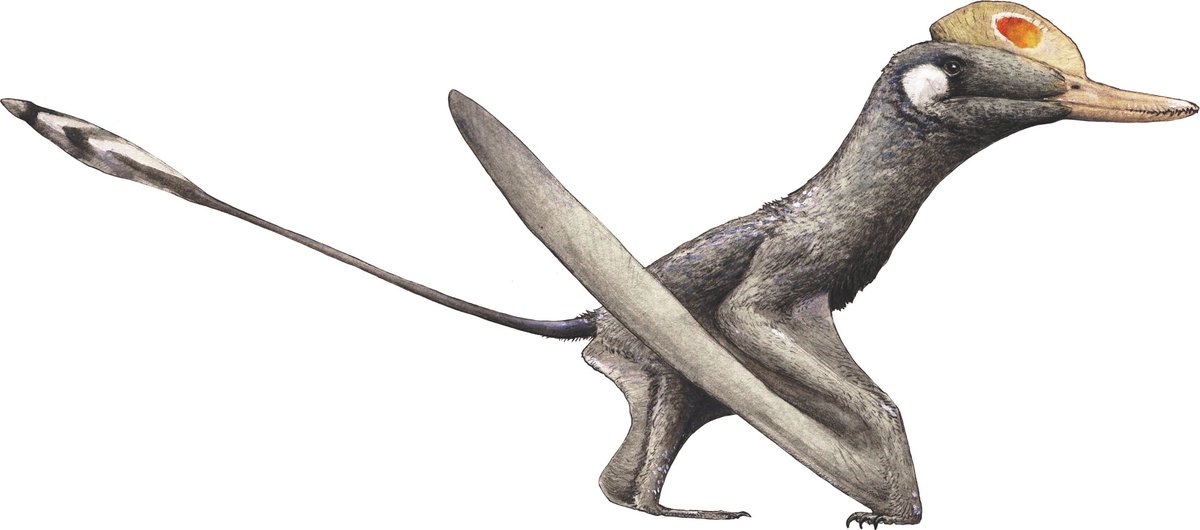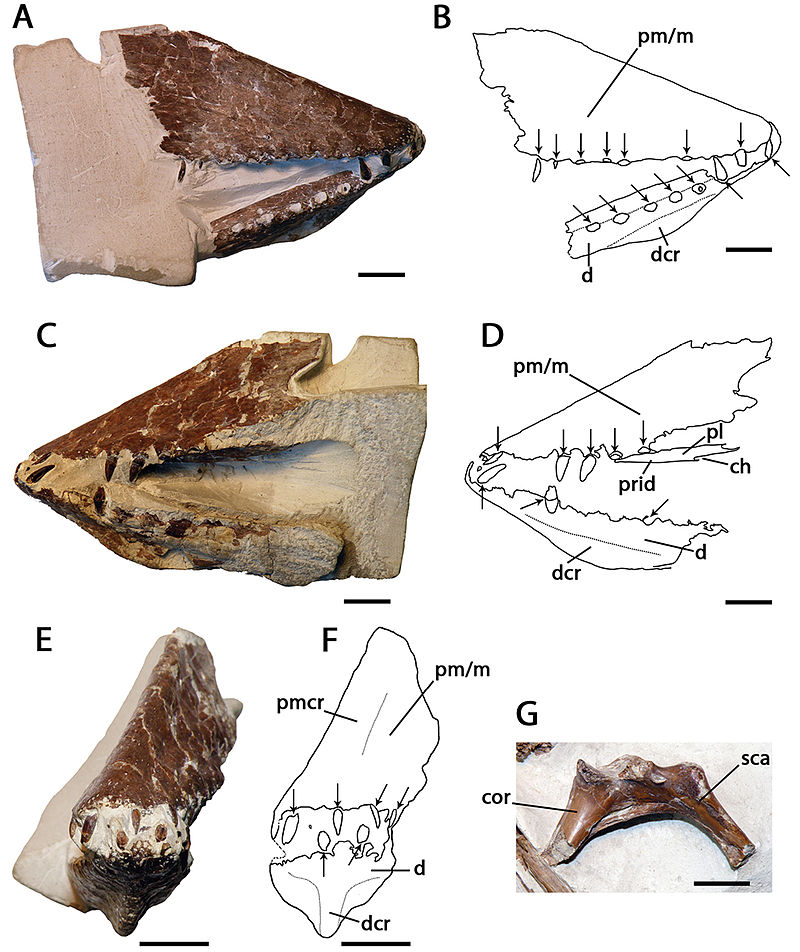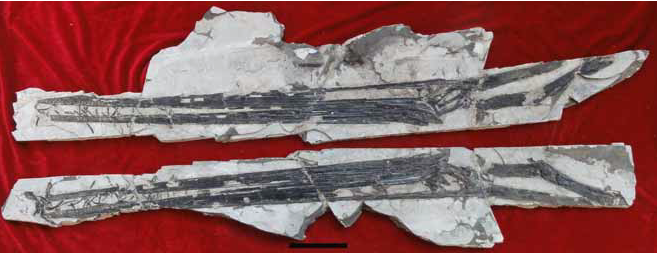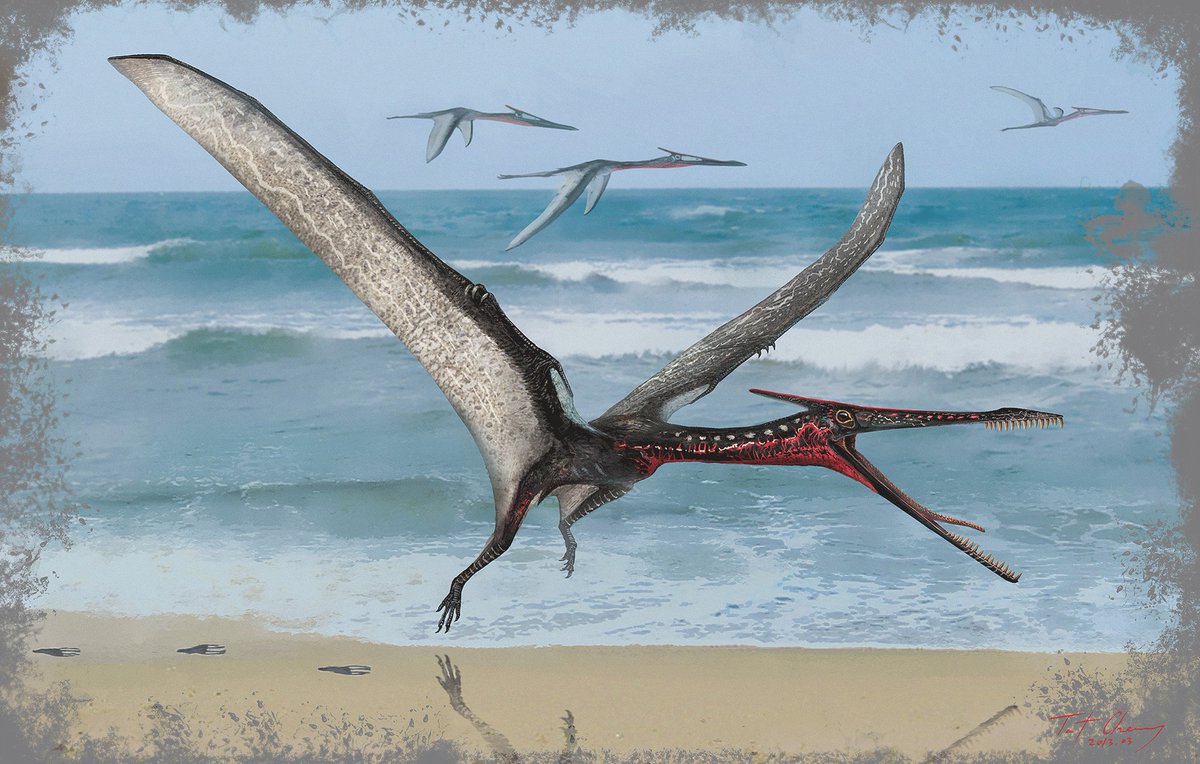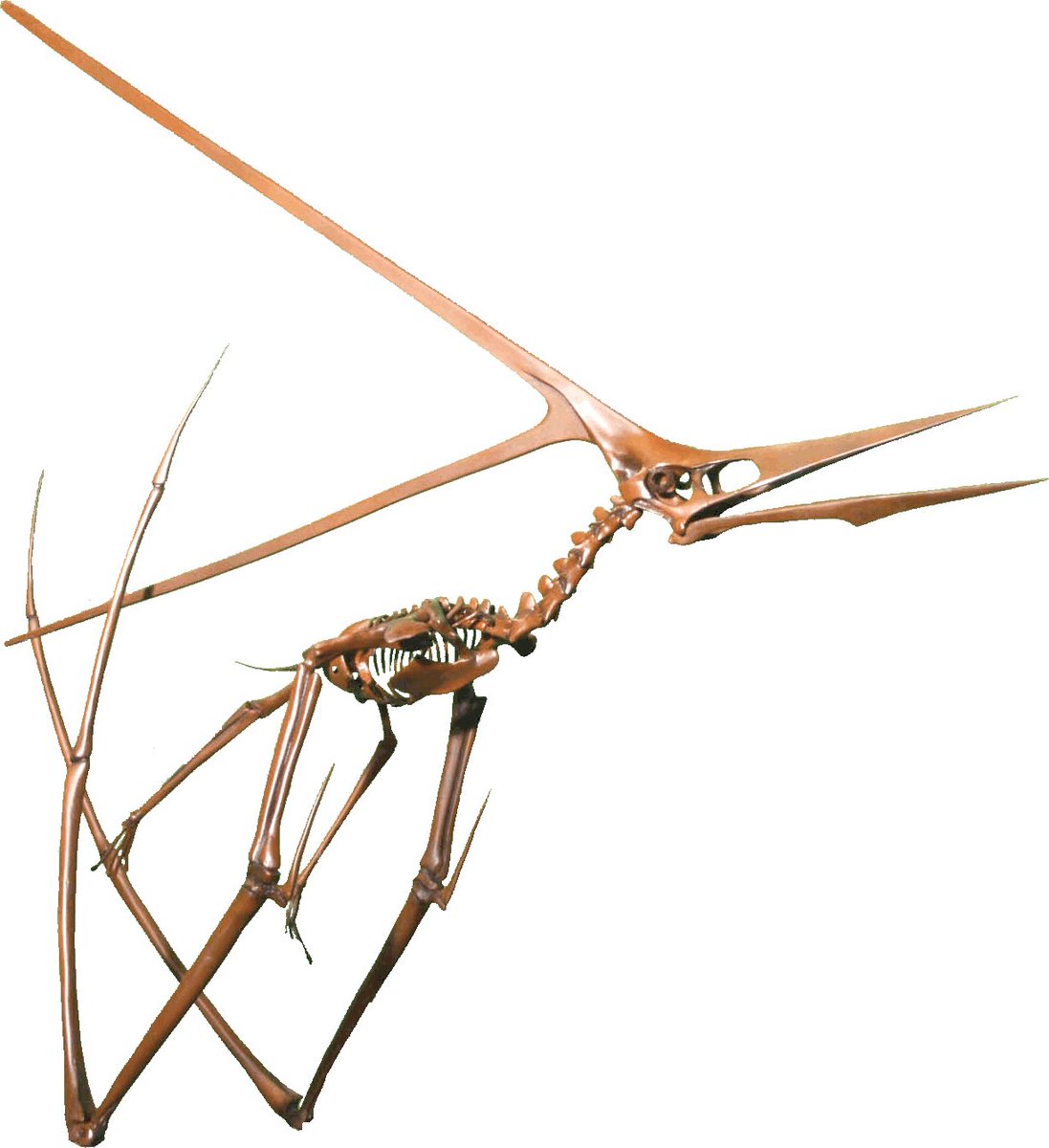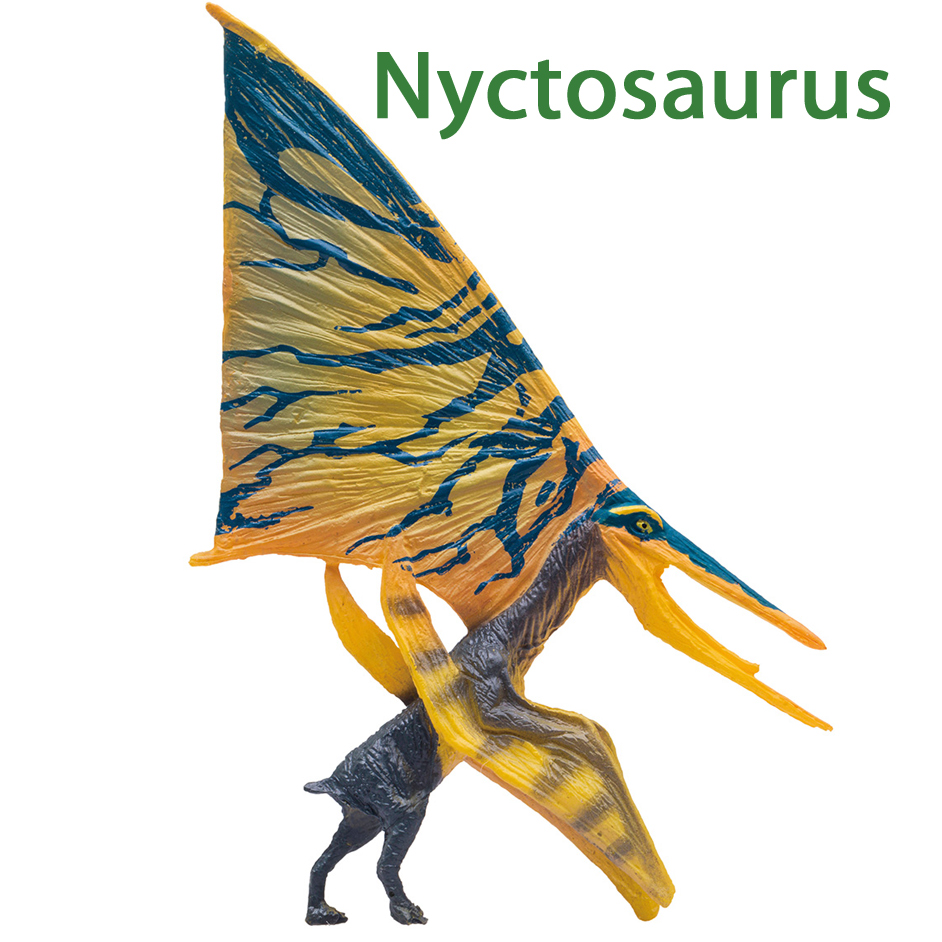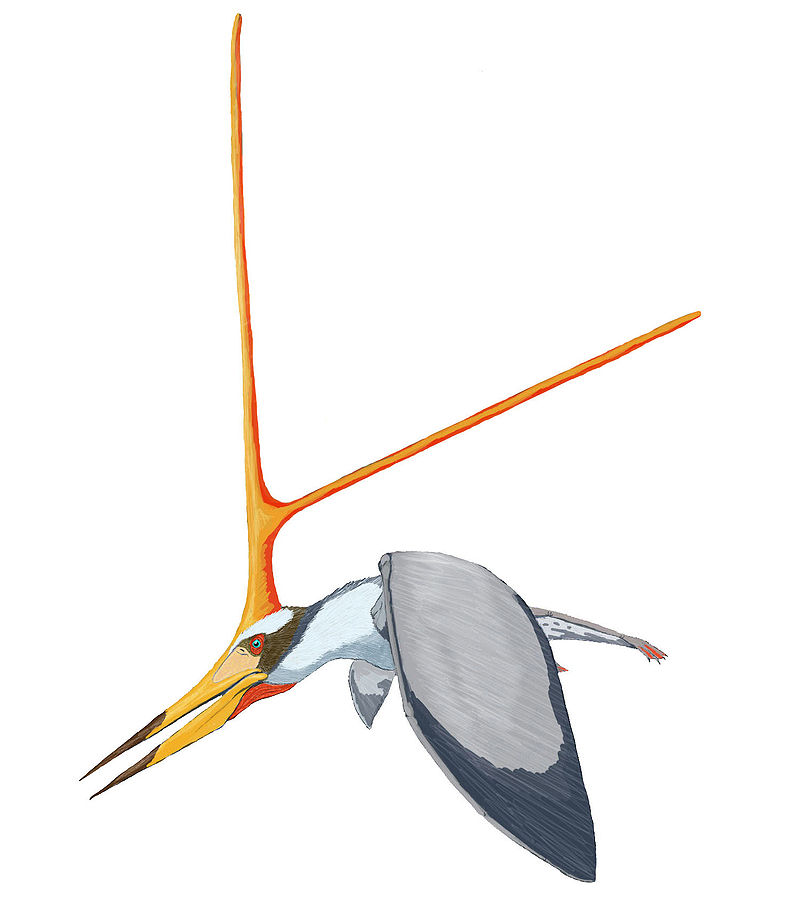So with nearly everyone cut off from each other due to #COVID2019, I& #39;m gonna do a #pterosaur of the day thread, one for each letter of the alphabet. Will include photos, palaeoart and basic facts. Spread the word and check back every day for your favourite flying reptiles! 1/n
A: Austriadactylus "Austria finger". One of the oldest pterosaurs at ~208 Ma, lived in what is now the Italian and Austrian alps. ~1 m wingspan and a pronounced cranial crest. I sampled the holotype from @SMNStuttgart for my PhD in February 2018. 2/n
The entire specimen is figured here in Dalla Vecchia (2002). What makes this pterosaur especially interesting is its different types of teeth; elongate fangs at the front, serrated knife-like blades in the middle, and short, triangular cones at the back 3/n
Many pterosaurologists have speculated that these teeth were adapted for capturing and even processing small, fleshy food items. However, many of these ideas have gone largely untested. Reconstruction below by @flyingreptiles 4/n
Tune in tomorrow for B!
Tune in tomorrow for B!
#Pterosauroftheday B: Boreopterus. This pterosaur had a ~1.5 m wingspan and lived ~125 Ma in China. Back then the landscape was a series of lakes and volcanoes which Boreopterus soared above like an "inland albatross" (Dave Unwin, pers comms.) (Photo Jiang et al. 2014) 1/3
Excellent close-ups of those teeth! I sampled this specimen from Beijing in 2017, including its amazing slender teeth at the front of the jaws, perhaps for acting like a "fish-net" and its tiny triangular teeth for guiding fish towards the throat (photo: Jiang et al. 2014) 2/3
Lastly, amazing skeletal and full-bodied reconstructions by @MarkWitton (2013). Note the long tail, which is unusual for Cretaceous pterosaurs. Pterosaurologists are unsure if this relatively elongate tail had any function (3/3)
#Pterosaur of the day. C: Ctenochasma "comb-jaw" Lived 150–145 Ma in Germany. Gets its name from its several hundred, carefully arranged teeth. Unlike whales and flamingoes which have keratinous baleen, each one is a true tooth with a root and pulp (photo: WikiCommons) 1/3
The comb-like structure is enabled Ctenochasma to filter-feed in shallow streams and pools. Recently, a coprolite (fossil poo) was described containing remains of small (2 mm long) clams, shrimps and worms. This pterosaur is the suggested main culprit (Qvarnstrom et al. 2019) 2/3
Lastly, a fantastic reconstruction by @flyingreptiles. Adult specimens possess a crest which have been used for display to attract mates and/or intimidate rivals 3/3.
#Pterosaur of the day D: Dsungaripterus "Junggar wing". Lived in China during the Early Cretaceous. Amazing upturned jaws and anvil-shaped teeth, thought to be adapted for crushing mollusc and crustacean shells found on beaches #FossilFriday (Photo Sues 2019) 1/3
Me posing awkwardly in front of the holotype at the Geological Museum of China, Beijing in July 2017. I unfortunately never got to sample Dsungaripterus for my PhD as the tooth enamel was very poorly preserved on the handful of known specimens #FossilFriday 2/3
Lovely #palaeoart reconstruction (here dubbed, "Rusty") by James McKay, who did this piece for me in 2015. The Dsungaripterus skeleton is relatively robust which has led to suggestions that it was, by pterosaur standards, a competent walker and even runner 3/3
#Pterosaur of the day E: Eudimorphodon "true dimorphic teeth". One of the oldest pterosaurs, lived 210-202 Ma in Northern Italy. With a wingspan of ~1 m, it would have flown over the shallow lagoons that formed Italy at this time (P; Sues 2019) 1/3
Close-up of the the serrated teeth at the back of the mouth with five cusps! What& #39;s more, these teeth show wear facets (pointed out) which shows *possible* tooth-tooth contact and thus rudimentary chewing (of sorts) (Osi 2011) 2/3
Full-bodied reconstruction from @flyingreptiles. Amazingly, fish scales with thick layers of gaonine (a mineralised compound) have been preserved in its stomach which suggests it liked to feed on some pretty hardy foods! 3/3
#Pterosaur of the day F: Feilongus (from feilong, the Chinese term for flying dragon). Lived in Central China 125 Ma. Flew over lakes looking for fish with 2.5 m wingspan. In between its jaws is a preserved fish (Wang et al. 2005). 1/3
Early fossils were described as this pterosaur having some sort of "overbite" i.e. the upper jaw was at least 10% longer than its upper jaw... (Wang et al. 2005) 2/3
This has resulted in some interesting reconstructions, shown below (Left by @JoschuaKnuppe, Right by @paleofan). Later fossils have shown this was a preservational artefact, and that Feilongus had two equally sized jaws 3/3
#Pterosaur of the day G: Gladocephaloides "sword head". Named after its triangular, elongate head, this pterosaur lived 120 Ma in western China. This specimen from Jinzhou Paleontological Museum (Lu et al. 2016) 1/3
Close-up on the head of another specimen shows preserved "hairs", termed pycnofirbres. Gladocephaloides was thus fuzzy and not scaly, likely for insulation, and provides more evidence that #pterosaurs were warm-blooded (Lu et al. 2012) 2/3
Gladocephaloides reconstruction from Lu et al. (2016). This #pterosaur is a supposed fish-feeder, flying low over lakes and rivers and plucking out fish whilst on the wing 3/3
#Pterosaur of the day H: Hamipterus "Hami wing". Lived 120 Ma in central China. This pterosaur exhibited sexual dimorphism with the females panel A, having smaller crests n their heads than the males in panel B. (Wang et al. 2014) #PterosaurPtuesday 1/3
In 2017, a huge discovery was made, over 200 Hamipterus eggs found from a single site! What& #39;s more, some of the bones of the embryos are still preserved inside! (Wang et al. 2017) #PterosaurPtuesday 2/3
This has led to reconstructions of Hamipterus, and all pterosaurs(?), as communal nesters who looked after their young similar to modern birds. However, this is disputed by some who argue that pterosaur reproduction was more like reptiles (by Zhao Chuang) #PterosaurPtuesday 3/3
#Pterosaur of the day I: Istiodactylus, "sail finger". One species lived 125 Ma on the Isle of Wight, UK (I. latidens) and one in central China (I. sinensis). I. latidens had a 4–5 m wingspan and amazing serrated, triangular labio-lingually flattened teeth ( @MarkWitton 2012) 1/3
The interlocking arrangement of Istiodactylus teeth (Martill 2014) are superficially similar to the tooth arrangement of modern cookie cutter sharks, who bite onto sides of fishes and dolphins and twist off circular pieces of flesh (Photos: Australian Museum & Wikipedia) 2/3
Such twisting behaviour has not been tested, but Istiodactylus is often reconstructed as the Cretaceous equivalent of modern vultures scavenging off dinosaur carcasses and ripping off pieces of flesh. Fantastically illustrated below by @MarkWitton 3/3
#Pterosaur of the day J: Jeholopterus. "Jehol wing" Lived 164 Ma in Western China. One of the smallest pterosaurs with a wingspan of just 90 cm, but one of the best preserved with wing fibres and pycnofibres clearly preserved (L; Elgin et al. 2011, R; Wang et al. 2002) 1/3
More recently described specimens have been described with tufted pycnofibres, leading to the suggestion that these fibres are in fact homologus to dinosaur and bird feathers, rather than analogous, although this is still disputed (Benton et al. 2019) 2/3
One of the crazier Jeholopterus reconstructions, below by Dave Peters, shows a bizarre set of tufts and frills and has this pterosaur feeding on dinosaur blood like a vampire bat! This appearance and feeding ecology, however, is dismissed by people who look at actual evidence 3/3
#Pterosaur of the day K: Kungpenopterus. Lived 154 Ma in central China. Belongs to a special group of pterosaurs that possess both basal and derived characteristics (e.g. the tail and head resp.) showing evidence of modular evolution #FossilFriday (Cheng et al. 2013) 1/3
What& #39;s more, a crestless Kungpenopterus was found with two unlaid preserved eggs (black circles). Not only did this show that only males possessed crests, but that this pterosaur did NOT reproduce like birds, who only lay one egg at a time (Wang et al. 2015) #FossilFriday 2/3
Lastly, the cutest li& #39;l reconstruction of a crested male Kunpengopterus by @JoschuaKnuppe The crest was likely used to attract mates and ward off rivals. 3/3
#Pterosaur of the day L: Lonchodraco (Lance Dragon). Named after its triangular head, Lonchodectes lived ~100 Ma in southern UK. Not much is known about this pterosaur besides the tips of its jaws, shown below (Rodrigues & Kellner 2013) 1/2
...No full-bodied reconstructions of Lonchodraco therefore exist. Pterosaurologists tentatively speculate that the jaws were used like sugar tongs to prob into sand and procure food items, illustrated below by a Pterodactylus ( @thejohnconway 2013) 2/2
#Pterosaur of the day M; Moganopterus. Lived 125 Ma in central China with a 5 metre wingspan. The slab and counterslab of its skull shown below. With a skull just under a metre long, Moganopterus possesses the largest head of any toothed pterosaur (Lu et al. 2012) 1/2
Moganopterus only possessed teeth at the front of its jaws, which are believed to have acted as a "fish-trap" for catching items along the Cretaceous coastline. (By Cheung Chung Tat) 2/2
#Pterosaur of the day N: Nyctosaurus. A smaller (2m wingspan) relative of the famous Pteranodon, Nyctosaurus lived 85 Ma over the shallow seas of what is now the US Mid-West and east Brazil. Reconstruction by Triebold Paleontology Inc. 1/2

 Read on Twitter
Read on Twitter